Scientists involved in the CGIAR Research Program on Forests, Trees and Agroforestry (FTA), Flagship 1 Livelihood Systems, recently discussed the future of their research in the next phase starting 2016. Researchers from all FTA Flagships spent most of August developing their pre-proposals for the CGIAR. The Livelihood Systems research is led by the World Agroforestry Centre (ICRAF) and coordinated by Fergus Sinclair. He encouraged his colleagues to share their thoughts on the Yammer platform, the below is an edited version of that discussion.
Increasing the value that smallholders get from timber, food and fuel production

Fergus Sinclair: Here’s a brief summary of the rationale for a research cluster on smallholder timber, fruit and other non-timber forest products (NTFP). These are grown on farms, gathered from or cultivated in forests, and are often traded locally. They have value added locally (for example in furniture manufacture, or dried fruit, jam or juice) and contribute substantially to many smallholders’ incomes. Land and tree tenure can create barriers keeping people – often women – from obtaining benefits from trees and associated products. Forest legislation tends to keep farmers from exploiting timber in managed fallows at forest margins.We are researching how smallholders can 1) get improved access to lucrative and legal timber and fruit markets, 2) harness opportunities for expanding sustainable harvests of a diversity of NTFPs and 3) find ways of increasing income from fruit trees through incorporating quality germplasm and appropriate tree management into farming systems.

 “
“Amos Gyau (ICRAF): For the future of FTA, it will be useful to include research activities on sustainability issues in food and bioenergy supply chains. My rationale is the following: many agricultural supply chain actors including farms and agribusinesses are currently engaging in some type of sustainable production and sourcing techniques in order to reduce both operational risks (e.g. degrading ecosystem services) and reputational risks (e.g. negative perceptions by consumers). However, these efforts are poorly linked with initiatives led by governments, donors, and NGOs, which commonly emphasize increasing benefits to small-scale producers, communities, and ecosystems.Therefore it will be useful and interesting to examine how public, private and civil society actors work together to promote sustainability in their supply chain at the various levels from farm to landscape. We can do this by documenting the prevalence and type of mechanisms used to implement a holistic approach to sustainable agricultural supply chains that operate beyond the level of individual production units and coordinate incentives, planning, and action by multiple stakeholders from the public, private, and civic sectors.
My suggestion is for us to focus on cocoa since we have a good case and experience from a project with Mars Inc and others in Los Angeles.

Jason Donovan (ICRAF): It’s great to see a Cluster of activities being proposed around value chains for smallholder timber, fruit, and NTFPs. It’s at the intersection of livelihoods and value chains where things get really interesting from a rural development perspective.
The proposed Cluster is also forward looking: value chains for fruits and smallholder timber will be increasingly important in a more urban and middle-income world. The 5Capitals tool for assessing the impact of value chain development emerged out of recognition that understanding livelihoods strategies and asset endowments was key to designing better value chain interventions (the tool was supported by PIM).
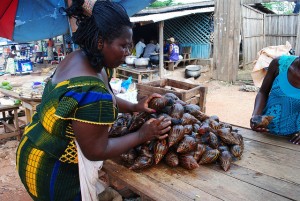
The links with the CGIAR Research Program on Policies, Institutions and Markets (PIM) are clear. 1) In PIM, only a few researchers are focusing on fruits and no one is talking about timber or NTFPs, 2) the livelihoods focus would fit nicely in the proposed Clusters 2 and 3 of the PIM value chain Flagship (where Cluster 2 deals with prioritisation of value chain innovations and Cluster 3 deals with the scaling up of innovations), and 3) there is strong potential for FTA to employ key tools from Phase 1 of PIM that have a focus on inclusive value chains (e.g., linked by CIAT, PMCA by CIP, and 5Capitals by ICRAF/Bioversity). CIAT, CIP, ICRAF and Bioversity are all working on gender versions of their Flagship PIM tools – these too might be of interest for this proposed Cluster.
The links with the CGIAR Research Program on Agriculture for Nutrition and Health (A4NH) are also clear and important: as incomes rise in developing countries and as countries become more urbanized, too few households are consuming more fruits and vegetables – while consumptions levels of meat and dairy products are rising. How to build value chains to supply growing urban markets with quality fruits will be an increasingly important issue. We’ve started to look at this in PIM, but there is a lot to do!
There are some good articles related to livelihoods and value chain development (see articles here, and here). The second article makes a call for R&D on the business side of community forestry management.
The development of small and medium enterprises (SME) is a critical issue for value chain development that doesn’t seem to have a home in either PIM or FTA, and thus presents an opportunity for this Cluster on value chains and smallholders. The cases of fruits, NTFPs, and timber products are all challenging for SME development and there is a lot of scope for new thinking about innovations in the business context and in SME organization.

Amos Gyau: The Cluster on smallholder timber, fruit, and NTFP perfectly fits into our interest and experience, as Jason said. Our experience from the past five years provides insights into new areas of research which can help to improve the livelihoods of smallholders.
For timber, fruits and NTFPs, it will be interesting to examine alternative financing options to improve smallholders’ participation and value chains. Access to credit is seen as one of the key constraints to farmers’ participation in markets. It is expected that, if we are able to design more effective financial instruments for different groups in different contexts, smallholders’ participation can be improved. For instance many farmers find it difficult to access credit for trees basically because it takes very long time until there is a harvest.
Another important research topic is to understand how to promote sustainable value chains for trees for food, timber and bioenergy. Sustainable sourcing is gradually becoming mandatory for market access and hence smallholders need to improve their game to become part of the regional and international markets for timber and other fruit products.
Finally, assessing the effectiveness of innovation platforms to improve farmers’ livelihoods will be of interest. (Photo of Amos Gyau: Adelaide University)
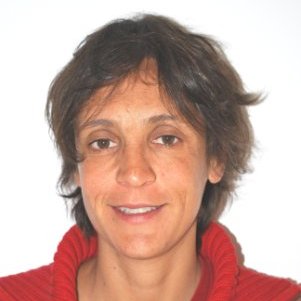
Valentina Robiglio (ICRAF): You are right Amos, and we should not forget the institutional aspects that regulate access to market in particular for smallholder timber, marketed locally, most often informally.
In the case of Peru one of the main barriers for farmers to be able to access formal value chains and credits etc. is the lack of legal land titles, and the complex bureaucracy they have to deal with if they want to get a permit to log – in case they do hold a legal title. It is important to look at the role of non-financial incentives like the establishment of concessions for smallholders or “enabling” titles that can give to farmers the right to market their timber and non timber forest products despite the fact that they do not legally own the land. The government of Peru has designed these forms of titles that are the same as those that enable farmers to access payment for ecosystem service schemes and carbon markets.
One of the issues now is how to make these kind of titles attractive so that farmers embrace being formally involved and invest in those markets. Some agroforestry practices might be preferable to conventional tree plantations, obviously depending on the species used (fast or slow growing) and the other components and services provided.
I think we still need to characterize and model some of those systems, in particular in the Amazon, in Brazil and Peru. Current momentum for agroforestry – because of low cost restoration, synergies in climate change adaptation/mitigation – calls for a push toward better understanding of those systems, of the factors that make them work and of their actual impact on soil etc. So let’s look also at non-financial incentives and let’s continue to characterize and model systems to be able to understand possible innovations.


Valentina Robiglio: We need to know how to ensure that laws support and encourage agroforestry uptake, that law-makers understand what agroforestry is and see its potential. We can also think at a scale of land holdings/fincas/farms as an agroforestry mosaic. So instead of looking only at the plot level, consider the entire production unit as a mosaic of (shifting) land uses with stable components that are the remnant forest, permanent crops and home gardens etc.
Relevant here are some presentations from the technical round-table Agroforestería y productores familiares: El apoyo de ICRAF a los procesos de reformas en el sector forestal de Brasil y Peru in Lima, attended by representatives of the National Forest Service, Ministry of Environment, some national NGOs and international cooperations and institutions.
In Brazil, we are pretty advanced on definitions, and in Peru we are contributing to building a common language by showing the evidence for a new definition of agroforestry systems and multiple functions of agroforestry systems. The aim is to succeed in the implementation of mechanisms to formalize the role of family farms and achieve conservation and restoration targets on public forests encroached by settlers. Indeed there is a high demand for that.


Anne Terheggen (ICRAF): But, are issues for smallholders any different to the general case for any sort of business? Smallholders, SMEs and other types of smaller-scale businesses face a set of common entry barriers to value chains, next to commodity specific barriers like technical firm-specific standards. The global value chain (GVC) is essentially a tool to study ANY industry or sector (note: Gary Gereffi first focused on textiles and manufacturing industries).I understand why certain commodities and crops are being clustered but I would not apply the unique GVC argument but rather reasons that are based on natural sciences. Given the same method is used in different CGIAR research programs, I understand PIM to be the forum for researchers across programs to engage with each other. There are already many financial tools available that are directed towards smallholders and at times adjusted for shariah banking systems. So, rather than reinventing the wheel, we should discuss how to specifically deal with the long growth and gestation periods of forest and agroforestry enterprises when it comes to financial instruments.

Jenny Ordonez: I agree with Valentina that a key step is to work on making tree resources on farms “visible” for policy makers. Obstacles here are the lack of definitions of the resource and lack of estimates of benefits and costs of using it. But more important is that regulation of tree resources on farms is fragmented between institutions that literally speak different languages – environment vs. agriculture.
Thus, it is necessary to work closely with national institutions to harmonize their views of the resource and develop definitions of what agroforestry is, how to quantify and monitor tree resources. We also need to show the potential they have for livelihoods and income generation and support national processes to develop strategies and assess policy changes to get key actors around the same table.
At subnational and community levels work to strengthen local institutions is needed, in part to improve knowledge about management but more importantly about how to organize, administer and monitor tree resources.
Local communities need to be given the opportunity, capacities and tools to use and control their resources. This is probably where links to market driven approaches will have a major role, supporting the development of value chains that foster sustainable use of the resource.

Challenges of FTA phase 2: Raising the profile of perennial tree crops

Fergus Sinclair: Tree crops produce important globally traded commodities including cocoa, coffee, rubber and oil palm that form the basis of smallholder livelihoods. Cocoa and coffee alone cover 20 million ha and are the mainstay of over 30 million smallholder households.
There is heated debate around the need to intensify production and how to do this without aggravating environmental and social damage. A plethora of certification schemes bear witness to this dilemma.
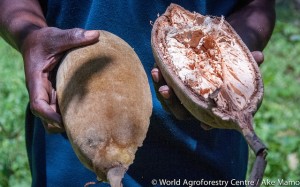 In Phase 1 of the CGIAR Research Program on Forests, Trees and Agroforestry, we proved how important trees are to sustain soil fertility and yield in cocoa production. Trees on farms also allow farmers to diversify and contribute to food security.
In Phase 1 of the CGIAR Research Program on Forests, Trees and Agroforestry, we proved how important trees are to sustain soil fertility and yield in cocoa production. Trees on farms also allow farmers to diversify and contribute to food security.
Yield gaps for coffee vary at fine scale in relation to soil condition and farmer practice, with trees having the potential to buffer anticipated climate change effects.
We are developing a public-private partnership involving the sustainable trade initiative IDH and chocolate companies to set up a global fertilizer trial for cocoa that can provide a basis to develop recommendations for farmers across soil types and management regimes.
There is a huge area of recently planted rubber and we are providing farmers with realistic advice on future price trends and on developing practices that are environmentally benign and therefore sustainable.
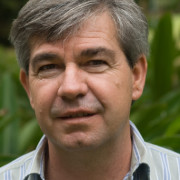
Philippe Vaast (CIRAD): Having a prominent research Cluster within FTA Phase 2 on perennial crops will indeed be a very good thing, but I strongly feel that perennial crops deserved more, such as a Flagship on their own – or even another research program of their own – due to their socio-economic and ecological importance in tropical countries. After all, coffee, cocoa, rubber, and oil palm contribute greatly to the revenues and livelihoods of around half a billion people in the humid tropics. These perennial crops are mostly produced by smallholders and mainly managed in agroforestry systems, so they have a recognized role in:
- revenue diversification/farmers’ risk management;
- provision of ecosystem services;
- as pioneer tropical crops on eco-certification;
- as cropping systems enabling synergies on climate change adaptation/mitigation; and much more.

They are at the center of far-reaching debates and research around trade-offs between production and ecosystem services, intensification, and discussions on land sharing/land sparing.
As all the CGIAR’s research programs are undergoing review of their structure and defining the contour of their future structure, Flagship leaders and other focal points have to make sure that these perennial crops stay high on the agenda.
More than 10 research projects are currently underway on perennial crops on all continents by the CGIAR centers, and there is the need to raise the profile of perennial crops in the absence of a stand-alone Flagship in Phase 2.
Therefore, it is important that we strongly advocate to strengthen ties between
- FTA Phase 2 and RTB Phase 2 as many roots, tubers and banana are grown in association with perennial crops;
- FTA Phase 2 and CCAFS Phase 2 as there are strong opportunities to study and promote synergies between adaptation and mitigation in perennial crops agroforestry systems;
- FTA Phase 2 and WLE Phase 2 on provision of ecosystem services at plot to landscape levels in watersheds and ecological zones where perennial agroforestry systems are important;
- FTA Phase 2 and PIM Phase 2 on the study and development of value chains, particularly on eco-certification where perennial crops such as coffee and cocoa have been pioneer tropical crops, and where there are good opportunities to strengthen research and development links with the private food sector. (Photo of Philip Vaast: Researchgate)


Farmers, trees and soil: integrated tree-crop-livestock systems
 “
“Fergus Sinclair: For FTA Phase 2, it has been suggested that we create a cluster called ‘Trees supporting sustainable intensification’ which needs to incorporate the research on soil health that we had earlier proposed as a separate cluster. Trees are an important cornerstone of system intensification in many contexts, because they improve and sustain soil fertility by 1) tightening nutrient and water cycling, 2) fixing nitrogen, 3) controlling erosion and 4) sustaining the soil biota.
By providing fuel wood and fodder on farms, trees free up labour for other tasks and may substitute for other resources, such as firewood being burned instead of dung, which can then be returned to soil. In Phase 1, we established that farmers typically retain a range of trees on farmland for different purposes with characteristic profiles of tree use and management. Farmers have detailed knowledge of tree attributes for a diversity of species that determine their utility for intensification.
We also established fine scale variation in performance of fertilizer trees in relation to landscape position, species, altitude, soil properties, rainfall and agronomic practice. Advances in genomics allow us, for the first time, to connect functional profiles of the living soil to different tree species, densities and management.
We are now combining high-end science with local knowledge to develop and test species diverse tree management options to intensify livelihood systems and increase their resilience. We are researching governance options to address tree ownership and control of free grazing of cattle that often prevent farmers from managing naturally regenerating trees on their land.

Edmundo Barrios (ICRAF): I would like to add that trees in agricultural landscapes have a shelter function for soil organisms that are ecosystem service providers, particularly during climatic extremes. Thus, they significantly contribute to functional resilience and the sustained provision of soil-mediated agro-ecosystem services.Developing a predictive understanding and greater ability to detect and quantify soil health benefits attributable to trees in agricultural landscapes requires an improved methodological approach. The use of spatially-explicit sampling approaches to examine tree/soil biota interactions has increased our capacity to detect and interpret changes in soil functional attributes resulting from the presence or strategic inclusion of trees in farmers’ fields and agricultural landscapes. The combined use of molecular tools, stable isotope analysis, and soil spectroscopic techniques will increase our ability to identify and characterize “hotspots” of soil biological activity across tree density gradients within spatially-explicit sampling frameworks in agricultural landscapes.

Didier Lesueur (CIRAD): We all agree that trees, especially fertilizer trees, play an important role in plant health because of the specific relationships they have with soil microorganisms through roots. But it is also clear that these relationships could be very much influenced by factors such as the management of the trees (for example, the pruning of woody legumes induces disappearance of rhizobial nodules), the environmental and soil conditions (the native microbial communities associated with tree roots can be totally different according to the soil characteristics with direct consequences for soil health) and the management of the soil itself (alley cropping with woody legumes, parkland with African acacias, fodder banks with woody legumes, mulching of the soil with crop residues or tree branches, soil fertilization with Rock P or mineral fertilizers).
In the literature, some case studies describe the impact of such factors on soil microbial communities with consequences for soil health. However, these results were rarely obtained in field conditions, and so are not really connected to farmers’ realities.
If I understood Edmundo correctly, it seems that during the first phase, you have made significant progress in filling this gap which sounds positive, because it doesn’t make sense to keep working under controlled conditions with no connection with the field reality.
But I don’t believe that we are through yet with such work and I would be pleased to contribute some ideas for the second phase if you think they are relevant for your project.
Basically, my suggestion is about combining a certain number of microbial parameters to get a better understanding of soil health and to make a link to the main ecosystem services – even if I am often cautious about this concept because it is used for everything. These parameters would include 1) assessment of the microbial communities; 2) genetic diversity of the microbial communities; 3) functional diversity of the microbial communities and 4) possible links between those microbial communities and the populations of nematodes living in the soil. For all these parameters we have lab tests to run to get the results:
- Counting of the microbial populations by the MPN methods on selective and non-selective media including arbuscular mycorrhizal fungus (AMF). By root staining, it is also possible to determine the level of root infection by AMF.
- By Illumina sequencing and bio-informatic approaches (metagenomic) including AMF, we know exactly which kind of microorganisms are naturally present in the soil and we can come up with patterns of genetic diversity.
- By using Ecoplates/Biolog we can have metabolic patterns for each type of soil
- By identifying the main groups of nematodes, we can have an idea about the level of fertility of the soil and its health status. In this area, we work with a French private company who does both counting and identification for us.
All these parameters are currently tested on rubber plantations in Thailand and we are planning to do the same on coffee plantations in Thailand and Vietnam, and maybe in Laos as well. I have been trying to apply them on oil palm plantations in South Thailand and Indonesia but nothing has been decided yet.
The approach is totally relevant and adaptable to any agroforestry systems because the objectives are the same. I am not sure if this has already been done by Edmundo and his team at ICRAF and I would like to work with you on that in the second phase.
One additional point is about what is happening in deep soil between microbial communities and roots of trees. We have been doing some research in Laos and it looks pretty interesting, even if the results are preliminary.


 “
“Edmundo Barrios: Good points. Please note that our Living Soils Lab has conducted significant soil biota and function research in the field – from single tree effect scale to sentinel site scale. I think it is key to look at plant-soil feedback and the role of plant functional traits, above ground and below ground, and organismal functional traits, and at how their interaction influences soil function and the provision of soil-based ecosystem services.We have conducted parts of what is proposed separately but have not put all the parts together in the same study, e.g. spatial analysis plus DNA analysis plus stable isotopes plus high through-put systems which enable large sample sizes (such as spectroscopic soil analysis and sequencing using Illumina). This, I believe, would be critical to strengthen our predictive understanding of the contribution of trees to sustain functional resilience and thus the supporting role to agricultural sustainability.

Didier Lesueur: That sounds great. I fully agree with you and I am impressed by your utilization of the methodologies you listed for having a better predictive understanding of the contribution of trees to sustain soil functioning and agriculture.
However, we know that so many factors can influence a system, especially farm conditions. And the main difficulty is to put them all together on the table and interpret them. Sometimes, you will get headaches and that’s because a field can look uniform but its soils can have huge variability.
We have been working with a soil physicist to make some links between geophysics measured by soil resistivity and soil biology through several parameters such as functional diversity, AMF root infection and structure of the total microbial communities. It seems promising and we have a Masters student working on it.
This is something important for us – ensuring even before a soil sampling that the sampling is relevant – because otherwise your results don’t mean anything. I guess that’s the reason for those headaches when we try to analyze our results obtained from farm conditions. Do you remember the work carried out by Bernard Vanlauwe about the soil fertility gradient around the farms in Central Kenya? How huge was the difference even over short distances!
I wonder if you and your team have done some tests in field/farm conditions with biochar? We have done them in Thailand, in the North East, where the rainfall is not high enough to accommodate rubber trees growing in poor sandy soils. In terms of soil biology, we are getting promising results and it may make sense to think about it in the second phase especially in areas with erratic rainfall.
This is something I am planning to promote in Central Viet Nam for growing new plantations of coffee in order to keep more water in the soil and to reduce the leaching of mineral nutrients applied in excess with a polluting impact on ground water causing a lot of health problems to local populations.
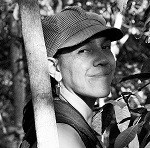
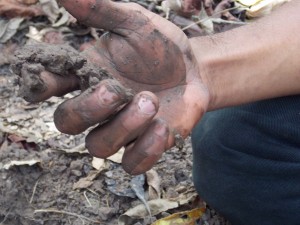 Geovana Carreño Rocabado (ICRAF): For farmers of Nicaragua, Central America, soil is a very interesting topic to be considered in the design of farm systems, since soil fertility is one the major constraints when it comes to increasing crop production. In the Nicaragua-Honduras Sentinel Landscape we are working with 120 farms looking at the relationship between agroecological intensification and properties of tree communities (i.e. density, diversity, structure).
Geovana Carreño Rocabado (ICRAF): For farmers of Nicaragua, Central America, soil is a very interesting topic to be considered in the design of farm systems, since soil fertility is one the major constraints when it comes to increasing crop production. In the Nicaragua-Honduras Sentinel Landscape we are working with 120 farms looking at the relationship between agroecological intensification and properties of tree communities (i.e. density, diversity, structure).
We are using soil properties as one of the key factors to evaluate sustainability of crop intensification. During our field work we were pleasantly surprised by farmers’ interest when we looked at their soils. We should leverage this openness to integrate farmers into our studies more often and to achieve more adoption of desirable management practices.


Didier Lesueur: Edmundo you are targeting more specifically deep rooting trees to increase soil C storage at greater depths. Which kinds of agroforestry systems do you have in mind? I guess you may think about native trees growing in arid and semi-arid areas, such as African acacia as some of them have deep roots that can get ground water even at a depth of 80 meters.
By working on such African acacia parklands, you also have the link with livestock systems as leaves and seeds are also sources of food for the animals. Are you thinking about other agroforestry systems? With regards to soil microbiology, so far little information is available about the existing relations between deep roots and the corresponding rhizospheric microbial communities. Many assumptions have been made but very few of them have been confirmed. We know the constraints and the difficulties of the investigations to be undertaken but if we decide to move forward on such a topic, it would be nice to have an idea about what has been done in terms of soil health.
It is known that root turnover is an important source of C in soil and it would be great to know what is going on in deep soils. The formation and presence of soil aggregates is often described in top soil of 0-30 cm because of the presence of the mesofauna such as earthworms. But what do we have when we work at a depth of 1 to 5 meters for example?
It is also known that the management of the trees affects the root growth and physiology as production of root exudates modifying the associated rhizospheric microbial communities. I am thinking about pruning which is widely practiced by farmers to give more light to the associated crops or to get some forage in order to feed the livestock. How does pruning affect the root system of the trees in the top soil and deeper?
In my point of view, it would make sense because by doing that we take into account the farmers’ knowledge of the management of the tree and as scientists we can come up with relevant scientific and practical activities to sustain agroforestry systems.

Edmundo Barrios: Great to have you on board! The plan is to look at different options to increase soil C storage on the soil profile as well as to restore soil function. Since WLE’s mandate is global we need to consider a diverse set of options as defined by the different contexts in which we will be working. Agroforestry trees as one of the options provides a natural link with agricultural land. In addition to acacias, I believe that deep rooting shrubs as part of farmer managed natural regeneration (FMNR) in West Africa, are important components to be considered which also contribute as fodder.
Pruning is a key management practice in FMNR and hence looking at its impact on root development and turnover with soil depth, as well as its contribution to increased soil aggregation and soil C storage, is already part of the action plan.
You may remember from our earlier communications the concept of trees as “refuges” for soil biota that contribute to preserving soil functional capacity. This would connect with the restoring soil function angle in a Phase 2 proposal. Furthermore, there is a significant component of participatory research embedded in the GrainGenes Germplasm Report (RDL) so that our experience in blending local and scientific knowledge can lead to better soil restoration decisions. I am glad to see that our thoughts continue to converge.

Further reading:












